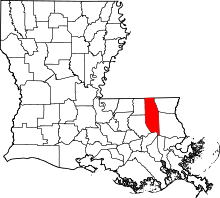Manchac, Louisiana
| Manchac, Louisiana | |
| Unincorporated community | |
 This view toward the north from midstream in Pass Manchac shows its confluence with North Pass (center). | |
| Country | United States |
|---|---|
| State | Louisiana |
| Parish | Tangipahoa |
| Elevation | 3 ft (0.9 m) |
| Coordinates | 30°17′30″N 90°24′07″W / 30.29167°N 90.40194°WCoordinates: 30°17′30″N 90°24′07″W / 30.29167°N 90.40194°W |
| Timezone | CST (UTC-6) |
| - summer (DST) | CDT (UTC-5) |
| Area code | 985 |
|
Location of Manchac in Louisiana
| |
 Location of Louisiana in the United States
| |


Manchac (also known as Akers) is an unincorporated community in Tangipahoa Parish, Louisiana, United States.
Fort Bute or Manchac Post, named after the then British Prime Minister John Stuart, 3rd Earl of Bute, was established in 1763 at the junction of Iberville River (Bayou Manchac) with the Mississippi River, and remained an important British military and trading post in West Florida until captured by Spanish forces under Bernardo Galvez of Louisiana on September 7, 1779, during what became known as Battle of Fort Bute of the American Revolutionary War. Manchac was raided in February 1778 by American forces under the command of James Willing[1]—see related articles, Continental Marines and USS Morris (1778).
Manchac is part of the Hammond Micropolitan Statistical Area. The name "Manchac" derives from a Choctaw expression for "rear entrance" (i.e., to Lake Pontchartrain). "Akers" is a namesake of Willie Akers, a telegraph operator on the New Orleans, Jackson and Great Northern Railroad, who in 1857 began operating Manchac's first post office.[2]
Manchac was one of the originally-planned stations along the railroad, generally at intervals of 10 miles. Akers' father, William Akers, was the first mayor of Ponchatoula, the station to the north of Manchac. Manchac straddles the railway, which is, at the start of the 21st century, part of the Canadian National Railway system.
Manchac is located on Lake Maurepas on the Pass Manchac waterway, which connects to Lake Pontchartrain. It is home to the ruins of one of the five lighthouses set up for Lake Pontchartrain, the Pass Manchac Light. The last lighthouse to be built on the north side of the entrance to Pass Manchac (the fourth one on that site) was completed in 1857. It was automated in 1941, and the dwelling was razed in 1952; the U.S. Coast Guard decommissioned the light and abandoned the property in 1987.[3]
Hurricane Isaac destroyed the Pass Manchac Light structure in August of 2012. However, the lantern room had previously been removed from the tower, for restoration purposes. Since 2008, Pass Manchac Light's lantern room has been located at the Lake Pontchartrain Basin Maritime Museum in Madisonville, Louisiana.[4]
Manchac is known for fishing, duck hunting, seafood restaurants like Middendorf's, and swamp tours. It is also home to the Port Manchac Distribution Center, with storage facilities and rail, truck, and water links to the east, west, and north. Interstate 55 has exit and entrance ramps for Manchac.
References
- ↑ Arthur H. DeRosier, Jr.: William Dunbar: scientific pioneer of the old Southwest, University Press of Kentucky, Lexington, Ky., 2007, pp. 39-44
- ↑ Lindsay, C. H.; Dufreche, Julian. "The History of Ponchatoula". Retrieved 2012-01-02.
- ↑ Lighthousefriends.com: Pass Manchac, LA, http://www.lighthousefriends.com/light.asp?ID=809, accessed 1 Jun 2010.
- ↑ Pass Manchac at LighthouseFriends.com accessed 25 Mar 2015.
External links
| Wikimedia Commons has media related to Pass Manchac, Louisiana. |
| |||||||||||||||||||||||||||||
